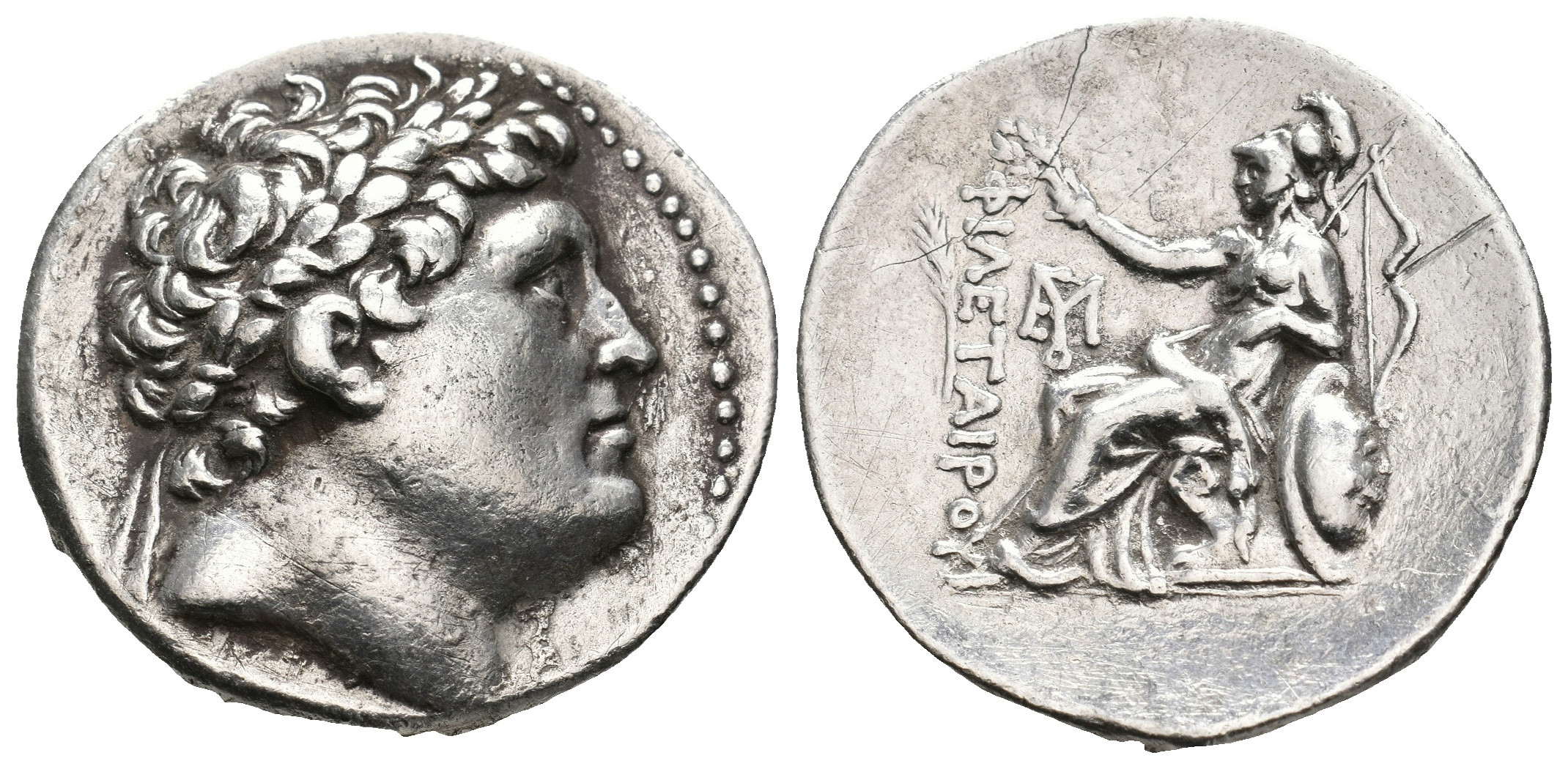Pergamum (Attalus I), silver, tetradrachms (241-197 BCE)
From SILVER
(Redirected from H 209 - Pergamum (Attalus I), silver, tetradrachms (241-197 BCE))
241 BCE - 197 BCE Silver 43,264 kg
Description
| ObverseInscription or printing placed on the obverse.: | Laureate head of Philetairos right. |
| ReverseInscription or printing placed on the reverse.: | ΦΙΛΕΤΑΙPΟY (Greek).Athena seated left on throne, resting elbow upon shield and crowning name. Controls: palm branch outer left, monogram to inner left. |
Mint and issuing power
| MintIdentifies the place of manufacture or issue of a numismatic object.: | Pergamum | Ancient regionAncient region.: | Mysia | Modern countryModern country: Turkey | AuthorityIdentifies the issuing power. The authority can be "pretended" when the name or the portrait of X is on the coin but he/she was not the issuing power. It can also be "uncertain" when there is no mention of X on the coin but he/she was the issuing power according to the historical sources: | Attalid Kingdom, Attalus I (Attalid king, 241-197 BC) |
Chronology
| FromIdentifies the initial date in a range assigned in a numismatic context. | 241 BCE | toIdentifies the final date in a range assigned in a numismatic context.. | 197 BCE | PeriodTime period of the numismatic object.: Hellenistic 323-30 BC |
Physical description
| MetalThe physical material (usually metal) from which an object is made.: | Silver |
Median weightMedian of the weights of numismatic objects (in grams). in grams | 16.90 | DenominationTerm indicating the value of a numismatic object. Examples: tetradrachm, chalkous, denarius.: | tetradrachm |
StandardStandard.: | Attic |
Image

H209 Attalus I.jpeg [1]
References
| Die study referencePublication of the study: | Westermark 19601Westermark 1960 | ||
| Coin series referenceReference to coin series study: | Sear II2Sear II, n° 7219-7223, RQEMH3RQEMH, n° 209 | ||
Obverse dies distribution
| FrequencyFrequency of specimen in distribution. ᵖ | Number of obversesNumber of obverse dies. ᵖ (o) | % (o) | Number of coinsNumber of coins. (n) | % (n) | Die nameName(s) of the die(s). |
| 1 | 25 | 24.51 | 25 | 7.91 | 32, 35, 36, 37, 42, 47, 51, 54, 66, 67, 68, 71, 76, 77, 78, 80, 87, 91, 93, 99, 109, 117, 121, 129, 130 |
| 2 | 24 | 23.53 | 48 | 15.19 | 30, 33, 34, 39, 40, 45, 50, 56, 59, 70, 73, 75, 79, 81, 84, 98, 106, 110, 112, 114, 115, 122, 124, 128 |
| 3 | 16 | 15.69 | 48 | 15.19 | 31, 41, 58, 65, 69, 72, 74, 92, 96, 97, 118, 119, 120, 125, 126, 127 |
| 4 | 11 | 10.78 | 44 | 13.92 | 38, 52, 61, 82, 89, 90, 101, 102, 107, 116, 123 |
| 5 | 14 | 13.73 | 70 | 22.15 | 43, 46, 49, 57, 60, 62, 83, 86, 88, 100, 105, 108, 111, 113 |
| 6 | 7 | 6.86 | 42 | 13.29 | 29, 44, 48, 53, 63, 95, 104 |
| 7 | 3 | 2.94 | 21 | 6.65 | 55, 64, 94 |
| 8 | 1 | 0.98 | 8 | 2.53 | 103 |
| 10 | 1 | 0.98 | 10 | 3.16 | 85 |
| Total | 102 of 102 | 100 | 316 of 316 | 99.99 |
Reverse dies distribution
no distribution is available
Quantification
| Number of obversesNumber of obverse dies. ᵖ (o) | 102 | Number of singletons (o1)The number of singleton coins. ᵖ | 25 |
| Number of reverse diesNumber of reverse dies. (r) | 252 | Number of coinsNumber of coins. (n) | 316 |
| Coins per obverse dieNumber of coins per obverse die. (n/o) | 3.1 | Coins per reverse dieNumber of coins per reverse die. (n/r) | 1.25 |
| Reverse per obverse ratioRatio of obverse dies divided by reverse dies. (r/o) | 2.47 | Percentage of singletons (o1)number of coins (n) divided by the number of singletons (o1) ᵖ | 24.51 % |
| Original number of dies (O) (Carter 1983 formula)The estimation of the number of coins according to Carter 1983 ᵖ | 128 | Coins struck if 20,000 as average productivity per dieCoins made if the average productivity for obverses (according to Carter) is 20,000. ᵖ | 2,560,000 |
| Original number of dies (O) (Esty 2011 formula)The estimation of the number of coins according to the singleton formula in Esty 2011 ᵖ (O) | 150.62 | Survival rate if 20,000 as average productivity per dieSurvival rate if average productivity is 20,000. ᵖ | 0.00012 |
| Coverage (o = % of O) (Esty 1984 formula)Esty 1984 - coverage (% of O) ᵖ (o = % of O) | 92.09% | Die productivity if survival rate 1/2,000Average productivity if survival rate is 1/2,000. ᵖ | 4,937.5 |
| Weight of silver (in kg) if 20,000 coins per die (O = Carter formula)Carter 1983 * Median weight * 20000 (*10 if gold or electrum) ᵖ | 43,264 kg <br /> 43,264 kg | Die productivity if survival rate 1/5,000Average productivity if survival rate is 1/5,000. ᵖ | 12,343.75 |
Remarks